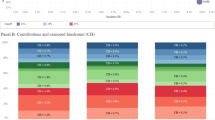Abstract
This paper describes and reviews the process of constructing a Multidimensional Child Poverty Measure in three sub-Saharan Africa countries: Mali, Malawi, and Tanzania. These countries recently (in 2015 and 2014) constructed a measure of multidimensional child poverty using UNICEF’s Multiple Overlapping Deprivation Analysis (MODA) methodology and conducted a comprehensive child poverty study including both deprivation and monetary poverty. This work describes how the methodology was adapted in the different contexts, discussing critical issues that arose during the study process, and compares the results of the three studies. The goal is to offer an overview of the different national processes and determine how similar or different factors influence the results.







Similar content being viewed by others
Notes
Defined as the $1.90PPP a day poverty line.
World Bank: ‘Monitoring global poverty: Report of the Commission on Global Poverty.’ Washington DC: World Bank 2017
E.g. for Nutrition, the indicator for moderate deprivation is a distance below 2 standard deviations (SDs) from the WHO reference, while severe deprivation is defined as 3 SDs below the WHO reference.
E.g. if any child of school age does not attend school, the whole household is deprived.
The Global MPI also report results for a threshold of 0.20 (vulnerability) and 0.50 (severe MD poverty).
For 2013 floods: http://www.unicef.org/media/media_67684.html; for 2015/16 droughts: http://www.aljazeera.com/news/2016/04/malawi-declares-state-emergency-drought-160413144707560.html
However this is likely not reflected in the data, which were collected before the start of the conflict.
Source: authors’ elaboration from survey data.
The same analysis is not available for Mali
It is important to highlight the essential role of the National Statistical Offices (NSO) in the process. Their involvement is essential to build sound ownership, and therefore credibility of the analysis. Furthermore, giving them an insight of what type of data and skills are needed for this type of analysis provides them with a reference for future data collection and analysis for e.g. annual reporting and SDG monitoring.
Integrated Survey on Agriculture.
The two age groups for children below the age of five consists of the same dimensions, but are separated in the national reports because they are composed of different indicators.
Tanzania being the notable exception, as mentioned above.
The cut-off point is 2 or more deprivations in Malawi, 3 or more in Mali and Tanzania (see above).
The X-axis is cut to the highest common deprivation number.
Indicators are grouped by dimensions as they were selected by the technical working groups in the country. Entries are left blank if not used in a country. Child labour was considered a separate dimension only in Mali, while the indicator on child labour was integrated in the Protection dimension for Tanzania and Malawi.
To keep results comparable, we use the logarithm of monthly consumption per capita.
References
Alderman, H., Chiappori, P.-A., Haddad, L., Hoddinott, J., & Kanbur, R. (1995). Unitary versus collective models of the household: Is it time to shift the burden of proof? World Bank Research Observer, 10(1), 1–19. https://doi.org/10.1093/wbro/10.1.1.
Alkire, S., & Foster, J. (2011). Counting and multidimensional poverty measurement. Journal of Public Economics, 95(7), 476–487.
Alkire, S., & Santos, M. (2010). Acute multidimensional poverty: A new index for developing countries. Human Development Research Paper 2010/11. New York: UNDP.
Alkire, S., Foster, J., Seth, S., Santos, M., Roche, J., & Ballon, P. (2015). Multidimensional poverty measurement and analysis. Oxford: Oxford University Press.
Bourguignon, F., & Chakravarty, S. (2003). The measurement of multidimensional poverty. The Journal of Economic Inequality, 1(1), 25–49. https://doi.org/10.1023/A:1023913831342.
Chauzal, G., & Van Damme, T. (2015). The roots of Mali's conflict: Moving beyond the 2012 crisis. CRU Report.
Chzhen, Y., & Ferrone, L. (2016). Multidimensional child deprivation and poverty measurement: Case study of Bosnia and Herzegovina. Social Indicators Research, 1–16. https://doi.org/10.1007/s11205-016-1291-8.
Chzhen, Y., de Neubourg, C., Plavgo, I., & de Milliano, M. (2016). Child poverty in the European Union: The multiple overlapping deprivation analysis approach (EU-MODA). Child Indicator Research, 9(2), 335–356.
de Milliano, M., & Handa, S. (2014). Child poverty and deprivation in Mali: The first national estimates. UNICEF Office of Research Working Paper WP-2014-20.
de Milliano, M., & Plavgo, I. (2014). Cross-country multiple overlapping deprivation analysis: Analysing child poverty and deprivation in sub-Saharan Africa. Innocenti working papers n. 2014-09.
de Neubourg, C., Chai, J., de Milliano, M., & Plavgo, I. (2012). Cross-country MODA study: Multiple overlapping deprivation analysis (MODA). Technical note. Innocenti Working Papers n. 2012-05. New York: UNICEF.
de Neubourg, C., de Milliano, M., & Plavgo, I. (2014). Lost (in) dimensions. UNICEF Office of Research Working paper WP-2014-04.
Duclos, J.-Y., Sahn, D. E., & Younger, S. D. (2006). Robust multidimensional poverty comparisons. The Economic Journal, 116(514), 943–968.
Gordon, D., Nandy, S., Pantazis, C., Pemberton, S., & Townsend, P. (2003). The distribution of child poverty in the developing world. Bristol: Center for international poverty research.
Hjelm, L., Ferrone, L., Handa, S., & Chzhen, Y. (2016). Comparing approaches to the measurement of multidimensional child poverty. Innocenti Working Paper 2016-29.
Newhouse, D., Suarez-Becerra, P., Evans, M., & Data for Goals Group. (2016). New estimates of extreme poverty in children. In Policy research working paper(7845). DC: World Bank.
Ravallion, M. (1998). Poverty lines in theory and practice. Living standards measurement study working paper(133). World Bank.
Roche, J. M. (2013). Monitoring progress in child poverty reduction: Methodological insights and illustration to the case study of Bangladesh. Social Indicators Research, 112(2), 363–390.
Roelen, K., & Gassmann, F. (2008). Measuring child poverty and well-being: A literature review. MGSOG Working Paper n. 1.
Roelen, K., Gassmann, F., & de Neubourg, C. (2010). Child poverty in Vietnam: Providing insights using a country-specific and multidimensional model. Social Indicators Research, 98(1), 129–145.
Sen, A. (1981). Poverty and famines: An essay on entitlement and deprivation. Oxford: Oxford University Press.
Sen, A. (2001). Development as Freedon. New York: Oxford University Press.
Sen, A. (2009). The idea of justice. Cambridge: Harvard University Press.
Tanzania National Bureau of Statistics & UNICEF. (2016). Child poverty in Tanzania. Dar es salaam. Retrieved from https://www.unicef.org/tanzania/resources_18551.html.
Tsui, K.-Y. (2002). Multidimensional poverty indices. Social Choice and Welfare, 19(1), 68–93. https://doi.org/10.1007/s355-002-8326-3.
UNDESA. (2016). Retrieved from https://sustainabledevelopment.un.org/index.html.
UNICEF Malawi. (2016). Child Poverty in Malawi. Retrieved from https://www.unicef.org/malawi/resources_18568.html.
White, H., Leavy, J., & Masters, A. (2003). Comparative perspectives on child poverty: A review of poverty measures. Journal of Human Development, 4(3), 379–396.
World Bank. (n.d.). World Bank DataBank. Retrieved July 2016, from http://databank.worldbank.org/data/home.aspx.
World Health Organization. (2011). WHO Guidelines on: Preventing early pregnancy and poor reproductive outcomes among adolescents in developing countries. Geneva: WHO.
Acknowledgements
The authors would like to thank colleagues in the UNICEF offices of Mali, Malawi, and Tanzania, and their partners who participated in the definition of the national multidimensional child poverty measure. In particular, we are grateful to the National Statistical Offices for their insights on national data and their crucial inputs in in the process. We also would like to thank our colleagues, and two anonymous referees, for providing comments and suggestions on this paper.
Author information
Authors and Affiliations
Corresponding author
Appendix
Appendix
Rights and permissions
About this article
Cite this article
Ferrone, L., de Milliano, M. Multidimensional Child Poverty in three Countries in Sub-Saharan Africa. Child Ind Res 11, 755–781 (2018). https://doi.org/10.1007/s12187-017-9487-2
Accepted:
Published:
Issue Date:
DOI: https://doi.org/10.1007/s12187-017-9487-2




